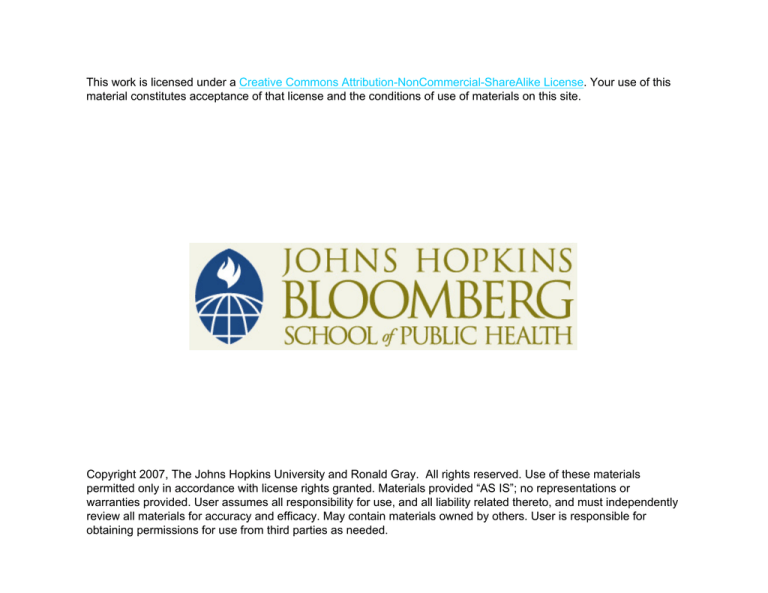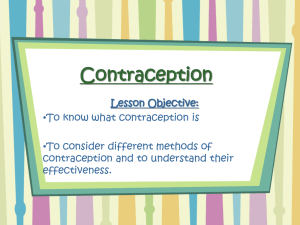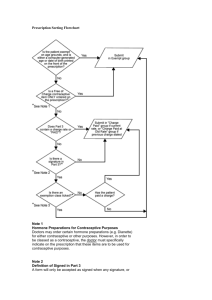
This work is licensed under a Creative Commons Attribution-NonCommercial-ShareAlike License. Your use of this
material constitutes acceptance of that license and the conditions of use of materials on this site.
Copyright 2007, The Johns Hopkins University and Ronald Gray. All rights reserved. Use of these materials
permitted only in accordance with license rights granted. Materials provided “AS IS”; no representations or
warranties provided. User assumes all responsibility for use, and all liability related thereto, and must independently
review all materials for accuracy and efficacy. May contain materials owned by others. User is responsible for
obtaining permissions for use from third parties as needed.
Lecture 4
Contraception Evaluation
Lecture Objectives
Measurement of contraceptive prevalence
Estimate use-effectiveness
Clinical trials to evaluate efficacy and safety
of contraceptives
3
Contraceptive Prevalence
Population-based surveys
Provider-based data
– Clinics
– Pharmacy prescriptions
– Surgical procedure surveillance
(abortion, sterilization)
4
Population Surveys
International Surveys
– World Fertility Survey (WFS)
– Contraceptive Prevalence Survey (CPS)
– Demographic and Health Surveys (DHS)
National Surveys
– National Survey of Family Growth
(NSFG)
Special Survey of Adolescents
Prevalence of use by method, age, and time
trends
5
Modern contraceptive use
United Nations Population Division. World Contraceptive Use 2001.
6
Contraceptive use among married women
United Nations Population Division. World Contraceptive Use 2001.
7
Type-specific contraceptive use in married women
United Nations Population Division. World Contraceptive Use 2001.
8
Total Fertility rates by region
C hildre n P e r W om a n
1950-1955
2003
7
6
5
4
3
2
1
0
Africa
Asia
North America
Latin
American &
Caribbean
Europe
9
Contraceptive Use in women 15-44, US
1982-2002
Using
contraception
Sexually active
but not using
contraception
1982
%
1988
%
1995
%
2002
%
55.7
60.3
64.2
62.0
7.4
6.7
5.2
7.0
Piccinino& Mosher Fam Plann Perspect 1998;30:4, AGI 2005
10
Contraceptive Use in women 15-44, by
Race; US 1982-95
1982
%
1988
%
1995
%
Caucasian
57.3
62.9
66.1
Black
51.6
56.8
62.1
Hispanic
50.6
50.4
59.0
Piccinino& Mosher Fam Plann Perspect 1998;30:4
11
P re v a le nc e %
Contraceptive Prevalence US 19722002
40
35
30
25
20
15
10
5
0
Pill
Sterilization
Inject/im plant
Condom
IUD
1
1972
2
3
4
Year
National Surveys of Family Growth
5
2002
12
Weakness of survey data
Changing sampling frame over time (e.g.,
exclusion of unmarried women <1980s)
Recall and reporting errors (e.g., omission
of induced abortion, timing errors)
13
Abortion Underreporting
Compare expected number of abortions
from surveillance data with reported
number from surveys
U.S. underreporting ∼ 30-40%
Underreporting of abortions
– Embarrassment / regret
– Reticence to admit contraceptive failure
14
Percentage
Reporting of Abortion in US
90
80
70
60
50
40
30
20
10
0
1976 1978
1980 1982 1984
1986 1988 1990
1992 1994
Year
Interview
Self-report
Interview and self-report combined
Of abortions estimated as having occurred among U.S. women aged 15-44 in
1995, percentage reported in Cycle 5 of the NSFG, by reporting of procedure
and year of abortion
15
Nearly half of all pregnancies in the
United States each year are
unintended
Intended
Pregnancies
Intended birth
43%
43%
Abortion
23%
Mistimed/
unwanted birth
19%
SABs
Miscarriage
9% 9%
Miscarriage
6%
Pregnancies, 1994
(6.3 million)
Unintended
pregnancies
The small proportion of
women who do not use
contraceptives . . .
. . . account for roughly
half of all unintended
pregnancies
Not
using
7%
Not
using
47%
Using
53%
Using
93%
Women at risk of
unintended pregnancy,
1995 (42 million)
Women experiencing
unintended pregnancies,
1994 (3 million)
Provider-Based Data
Contraceptive sales and formulations from
prescription surveys
Abortion from facilities surveys
– CDC surveillance
– Guttmacher Institute surveillance
Sterilization (tubal ligation, vasectomy)
procedures
18
Provider-Based Data on Contraceptive Use
National Prescription Audit (Pharmacy based)
Dispensed retail prescriptions of oral contraceptives by oestrogen potency.
United States, 1964-84. National Prescription Audit Data.
Despensed Prescriptions
(m illions)
70
60
50
40
30
20
10
0
64 65 66 67 68 69 70 71 72 73 74 75 76 77 78 79 80 81 82 83 84
High
Medium
Low
Year
Data Source: Piper JM and DL Kennedy. Internatl J Epi. 16(2): 215-221, 1987.
19
Oral Contraceptives in the United States: Trends
In Content and Potency.
Dispensed Prescriptions
(m illions)
70
60
50
40
30
20
10
0
64 65 66 67 68 69 70 71 72 73 74 75 76 77 78 79 80 81 82 83 84
High
Medium
Low
Year
Data Source: Piper JM and DL Kennedy. Internatl J Epi. 16(2): 215-221, 1987.
Arrow denotes change in database
20
Induced Abortion
Two surveillance systems
– Allan Gutmacher Institute (AGI)
– CDC
– Maintain surveillance of large samples of
providers
21
U.S. Abortion Rates
1973 - 1996
35
30
25
20
15
10
5
0
19
73
19
75
19
77
19
79
19
81
19
83
19
85
19
87
19
89
19
91
19
93
19
95
Abortion Rate (per 1,000
women)
Abortion Rate (per 1,000 women) in the U.S.
1973-1996
Year
Converted from Henshaw, 1998
22
Classification of contraception
Intercourse related methods
– Physical barriers; condom, diaphragm,
cervical cap
– Chemical: Nonoxynol 9 (N9) spermicides
– Periodic abstinence (Natural Family Planning
NFP)
Hormonal methods with daily compliance
– Combined oral contraceptives (estrogen &
progestin)
– Progestin only (for breastfeeding)
23
Classification of contraception ctd.
– Long acting methods
• Injectable: Depot Provera (3 months),
NET (2 mths), monthly combined Est
& Progestin
• Norplant, Jadelle
• IUD (copper and hormonal devices)
24
Implants (Brache et al Contraception 2006;73:364)
Norplant: Levonorgestrel 6 rods implanted
under the skin. Effective for 7 years
Problems
– Local irritation
– Difficult to remove
Jadelle: Levonorgestrel 2 rods, effective 5 years
Advantages
– Less local irritation
– Easier removal
25
Permanent methods
Female Tubal ligation
– Surgical (reversible, irreversible),
chemical
Male vasectomy
– Surgical (reversible, irreversible),
chemical
26
Contraceptive Use
Effectiveness
Definition:
– Measurement of the cumulative incidence
of events (e.g. pregnancy rates), and
continuity of use (continuation rates)
Sources of data:
– Retrospective data from surveys used for
population based estimates
– Prospective data from clinical trials used
for comparative effectiveness estimates
27
Data for Use-Effectiveness
Date of first and last use, or date of
withdrawal or last observation
Reason for termination (exclusive definition
varies by method)
Sociodemographic characteristics
– Age, parity, marital status
– Fertility intention (spacing/limiting)
28
Measurement of Use-Effectiveness
Pearl Pregnancy Rate:
Pregnancy per 100 woman years = total
accidental pregnancies / total years of
exposure x 100
– Problem of interpretation due to time
bias (combines months of use into an
aggregate total and assumes constant
risk)
– One woman using for 12 months, same
as 12 women using for one month
29
Measurement of Use-Effectiveness
Multiple decrement Life table Rates:
Estimates of cumulative continuation rates
and cumulative non-competing risk
discontinuation rates for specific events
30
Estimation of Use-Effectiveness
Population Surveys
Objectives: To compare pregnancy and
continuation rates between different types
of contraceptives in the general population
Methods: Population sample surveys using
retrospective interviews
31
Survey Estimation of UseEffectiveness
Advantages: Allows comparison between
methods in general use, shorter study time
and lower costs.
Limitations: Recall errors, underestimation
of induced abortion, self-selection affect
comparisons between methods. Need to
adjust for age, parity, SES and fertility
intention
32
Pregnancy rates with perfect and typical use, by method
85%
No Method
Spermicides
Periodic Abstinence
Diaphragm
Condom
Oral Contraceptives
IUDs
Depo Provera
Norplant
Female Sterilization
0
5
10
15
20
25
Percent of Women Pregnant/Year
Perfect use
Typical use
33
Effectiveness
By burden of
compliance
34
Contraceptive Failure
Method of contraception
– Failure rates higher with intercourse
related methods (barriers, NFP)
– Intermediate with non-intercourse
related, interval methods (e.g. Pill,
injection, implant, IUD)
– Lowest with permanent methods (e.g.
sterilization)
35
Factors Associated with Contraceptive Failure
Sociodemographic Characteristics
– Age
– Parity
– Marital status
– Education / SES
Motivation / Sensitivity
– Spacing vs. terminating reproduction
– Underreporting of unplanned pregnancy
– Underreporting of induced abortion
36
Relative Risk of Contraceptive Failure
(US 1995)
Characteristic
RR (95%CI)
Hispanic
1.25 (1.02-1.54)
Low-income
1.54 (1.28-1.85)
First use of any method
0.60 (0.48-0.76)
Higher edcuation
0.64 (0.44-0.2)
Desire for a child in the
future
1.77 (1.46-2.150
Trussell and Vaughan Fam Plann Perspect 1999;31:64
37
Semen exposure with Condom
failures
830 couples, women collect postcoital
vaginal sample for PSA and sperm
detection
No condom 97% PSA+, 79% sperm
Condom breaks 65% PSA+, sperm 38%
Condom slip 45% PSA+, sperm 0%
–
Walsh Contraception 2003, 67:139
38
Contraceptive Clinical Trials
Phase 1: Short-term pharmacokinetics and
pharmacodynamics, acute toxicity and dose
finding
Phase 2: Estimate of use-effectiveness in
non-comparative trial, determine clinical
regimen
Phase 3: Large-scale comparative,
randomized trials to establish useeffectiveness relative to standard treatment
39
Randomized Clinical Trials
Objectives: Comparison of useeffectiveness between two or more
methods of the same type of contraceptive
(e.g. IUDs, pills)
Methods: Random allocation within method
and prospective follow-up study, preferably
double blind
40
Randomized Clinical Trials
Advantages: Unbiased comparison,
comparability of treatment groups, good
internal validity
Limitations: Selected clinic population may
affect external validity.
Prolonged study and high costs.
Cannot compare across type of
contraceptive (e.g. IUD vs. Pill)
41
Multiple Decrement Life Table
Analysis
Multiple reasons for terminating
contraception, requires multiple decrement
life table
Competing risk rates: estimated for each
termination type, adjusted for losses to
follow-up and censoring.
– Estimates the relative frequency of
different terminations, rates are additive
42
Life Table Analysis
Non-Competing Risk Rates: Estimated for
each reason for termination, treating all other
reasons for termination as censoring.
– Provides unbiased estimate of
termination rates for each reason
separately, rates are not additive.
– Estimates are higher than for competing
risks
– Best estates for clinical trials
43
Competing Risk Rates
qx = Ex / Nx*
– Where qx is the conditional probability of
termination during the interval (x, x+1),
E the number of terminations and N* is
the adjusted population at risk
– Nx* = Nx - Wx /2, where Wx are the
withdrawals due to losses or censoring
in the interval (x, x+1)
44
Non-Competing Risk Rates
qx = Ex / Nx**
– Where qx is the non-competing risk
probability of terminating in the interval,
the N** the population at risk after
adjusting for withdrawals (Wx) and all
other reasons for termination (Tx)
– Nx** = Nx - (W + Tx /2)
45
Cumulative Rates of Continuation
and Termination
Cumulative rates of continuation,
P (0, x+1) are estimated from the product of
the interval retention rates (px), where:
– px = 1 - qx
– P (0, x+1) = p1 X p2 x p3 … px
Cumulative termination rates are:
– Q(0, x+1) = 1 - P(0, x+1)
46
IUD Trials: Events per 100 person years
Expulsion Removal
%
Bleeding
/pain %
Continuat
ion %
Copper T 0.5
3.7
2.2
76.3
Lippes
Loop
7.8*
4.5*
68.8*
Pregnancy
%
1.9*
WHO Contraception 1982;26:1-26
47
Post-coital Emergency Contraception
Combination of estrogen + progestin (e.g.,
COC) Plan B
Levonorgesterel
Low dose mifepristone (RU486)
Taken <72 hrs after unprotected
intercourse
48
Evaluation of Post-Coital
Emergency Contraception
Expected probability of pregnancy ~ 25% cycle
Emergency contraception ~1.5- 3% pregnancy
rate/cycle
8 studies suggest effectiveness ~81% with
intercourse on or before -1 day before ovulation
and 17% if intercourse occurred later
(Trussel Contraception 2003;67:167)
49
Access to post-coital contraception
Timing of use <72 hours critical
France
– Access without prescription and no fees
– Via pharmacies, school nurses etc
– 1.5 mill prescriptions since 1999, 97%
without prescription
US. Requires physician prescription,
restrictions on OTC by age, limits access
and causes delays
50






